
 |
|
|
|
|
#1 |
|
Vikingsword Staff
Join Date: Dec 2004
Location: The Aussie Bush
Posts: 4,398
|
Yuanzhumin:
Would you also care to identify the tribal origins of the following swords and knives? Example A: This one is from the collection of the distinguished host of this web site, Dr. Lee Jones, who posted the following pictures in 2001. OAL 28.75 inches (73 cm) 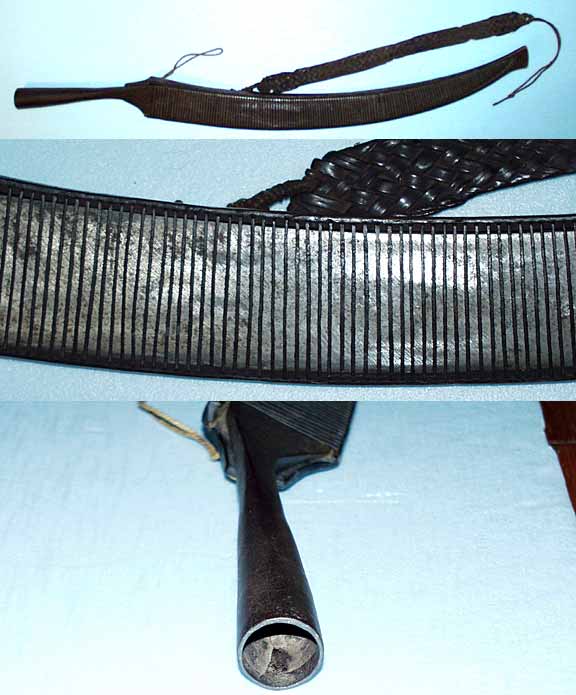 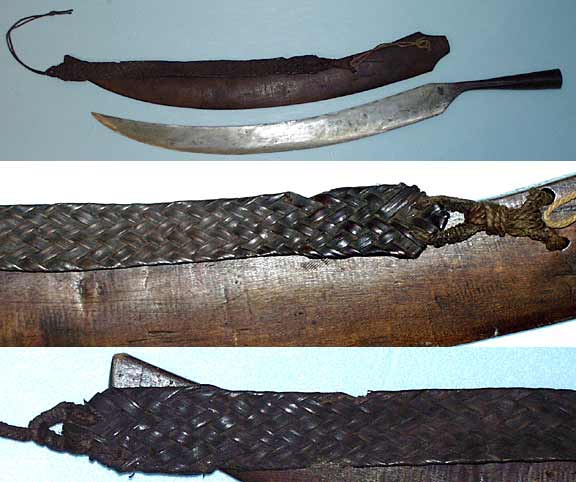 Examples B,C,D: These are from my own collection. B: OAL 19.75 inches. (50 cm) C: OAL 24 inches. (61 cm) D: OAL 34 inches (86 cm -- the largest of this style I have seen)  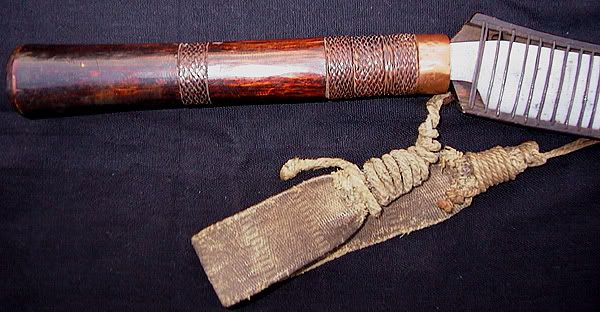  Example E: Another one of mine 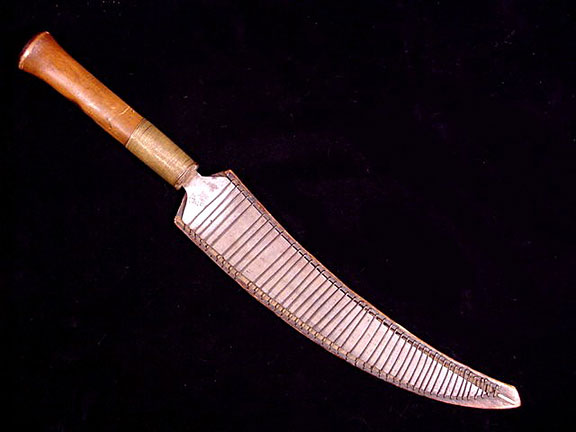 Thanks for any additional information you may have. Ian. Last edited by Ian; 17th September 2005 at 04:35 PM. Reason: Added dimensions in cm |
|
|

|
|
|
#2 |
|
Member
Join Date: Dec 2004
Location: What is still UK
Posts: 5,855
|
This is my one, sorry the picture is not very good. I am having peoblems with my camera wizard loading and editting program. This is the only one of these I have seen in the UK since I have been collecting. It was only through this site that I found out it was from Formosa. The total length of the blade and handle is 59 cm. Tim
Last edited by Tim Simmons; 17th September 2005 at 03:31 PM. Reason: adding more pictures |
|
|

|
|
|
#3 |
|
Member
Join Date: Dec 2004
Location: What is still UK
Posts: 5,855
|
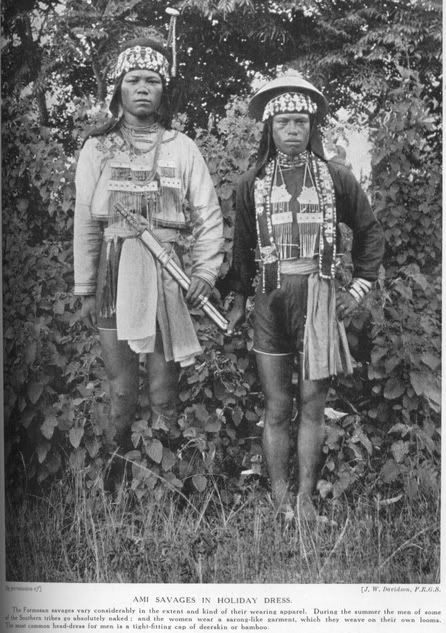
|
|
|

|
|
|
#4 |
|
Member
Join Date: Dec 2004
Location: What is still UK
Posts: 5,855
|

|
|
|

|
|
|
#5 |
|
Member
Join Date: Dec 2004
Location: What is still UK
Posts: 5,855
|

|
|
|

|
|
|
#6 |
|
Member
Join Date: Sep 2005
Location: Ex-Taipei, Taiwan, now in Shanghai, China
Posts: 180
|
I'm happy and flattered to have created such an interest in Taiwanese knives. Congratulations to all of you that showed me pictures ! You have all very nice knives from Taiwan. If one day you want to depart from them, don't forget to tell me first ! http://www.vikingsword.com/vb/images/icons/icon12.gif
 Well, I don't know from where to begin. Well, I don't know from where to begin. The first that was shown to me (Rick's one) was from the Rukai tribe, one of the Paiwan sub-group in the south of the island. It was straight, and straight is the way to recognise between the southern tribes' knives and the northern' ones. All the knives you have shown me after Rick's one are curved (even if it is slightly), so they are from the northern tribes. The common point to all the taiwanese tribes knives (southern, central and northern) is the one-sided sheaths and no guards. -So this is for Ian : Example A: you have a nice Atayal knife. I love the 'naked handle'. It is so modern and design ! Example B and D : These are nice Bunun or Tsou knives. These are the central tribes. Their knives are not as curved as the Atayal and not straight like the Paiwan. The two tribes are very close, and their knives (and other cultural traditions) difficult sometimes to distinguish. The Bunun are the most mountainous of the Taiwanese tribes, living at the highest altitude, considering the Yushan (formerly known as Mount Morrison) as a sacred mountain. The Yushan (close to 4000 m high) is one of the highest peak in South East Asia. C and D : Two other nice Atayal knives. The D is original for its length as you said, Ian, as usually the 'standard length' is between 50 and 60cm. -This is for Tim : Your knife has very nice proportions, the shape of the sheath is in the best Atayal style, beautiful... except one important thing : Atayal knives, I mean their sheathes, are not colored. I'm sure, without looking carefully at the red pigments I see on it, that this is not tribal painting but chemical painting done later. The Atayal are the principal group of the northern tribes. They are formed of three sub-groups : the Atayal proper, the Truku (Taroko) and the Seedeq. They are very close in their cultural traditions but still have enough differences, mostly in the language (half the same). The Atayal are today something like 60 000. The Atayal women are the best weavers and dressmakers of all the taiwanese tribes and they are renowned for their shellbeads clothes or shellbead jewellery.The Atayal, in opposition to the Paiwan groups, don't sculpt or carve the wood. So when the Rukai sheath is full of motives, like Rick's knife, the Atayal have none. But I would say that their beauty is not in the details but in the shape. Look at these blades slightly curved, the handles and the blades being one (example A from Ian and the one from Tim)! Their simplicity, purety is so modern. Even today the best designers with all their computers would not create a better balanced shape. Look at the sheath with the knife inside, it is not carved on it, but the whole together is like a sculpture. The sheath of the Atayal knife has the shape of a fish jumping out of the water, with the top bottom of the sheath being the tail and, on the middle edge of some sheathes (see the one from Tim), a kind of "back" fin, very slight, nearly invisible but so classy. Well, sorry for being so long ! |
|
|

|
|
|
#7 |
|
Vikingsword Staff
Join Date: Dec 2004
Location: The Aussie Bush
Posts: 4,398
|
Yuanzhumin:
Thank you for the prompt and informative responses. I think there are several people here who have collected these knives over the years. Apart from the book, Material Culture of the Formosan Aborigines by Professor Chen Chi-Lu, I have found very little to describe these swords and knives. The older ones I have handled have been uniformly well made with well forged blades, and sheaths that have been carved and fitted to the knives with considerable skill. There are, of course, modern "interpretations" which seem to have been made for the tourist industry. These come up from time to time on eBay and are usually mislabeled as "African" because of the animalistic carvings to the sheath and handles. I have seen both straight and curved varieties of these modern knives and swords, none of which have the quality of older pieces. Can you shed any light on whether knives and swords are still being made in the traditional manner by the respective Taiwanese aboriginal groups? Ian. |
|
|

|
|
|
#8 |
|
Member
Join Date: Jul 2005
Location: GA USA
Posts: 76
|
It is 13 inches long. Sharp blade.
|
|
|

|
|
|
#9 |
|
Vikingsword Staff
Join Date: Dec 2004
Location: The Aussie Bush
Posts: 4,398
|
Zalmoxis:
The rattan wrap on the handle looks typical work of the Naga or some of the nearby tribes, such as the Abor, in N.E. India. The closed scabbard is not typical of Naga or Abor, and may not be original to this knife; the scabbard could perhaps be from another nearby group or the result of an inappropriate "marriage." Nice looking functional knife. Here is one from the old forum that is attributed to the Abor people who live in N. Assam and neighboring Tibet, on the other side of the Bramaputhra River from the Naga. This one has an open scabbard similar to Naga dao, and reminiscent of the ones shown above on some Taiwanese swords and knives. There is no clear connection, however, between the Abor and Naga in N.E. India and the tribal groups of central and northern Taiwan that might suggest this is anything more than coincidence. Ian. Dao of the Abor people of N. Assam and nearby Tibet  Last edited by Ian; 18th September 2005 at 04:06 AM. Reason: Picture added |
|
|

|
|
|
#10 |
|
Member
Join Date: Jul 2005
Location: GA USA
Posts: 76
|
Ian thank you for info. I have another one almost identical in regard of the wooden sheath. I will post a pic later. Maybe the small knives from Naga had this kind of sheaths? The other one also this small size. I am not a specialist on the Naga but I have 2 daos and they are huge. Maybe they are women knives?
|
|
|

|
|
|
#11 | |
|
Member
Join Date: Sep 2005
Location: Ex-Taipei, Taiwan, now in Shanghai, China
Posts: 180
|
Quote:
I read recently the hereafter interesting article and thought it was, in some ways, answering the question. (In order to better understand the context : Truku (or Taroko) is the name of one of the 13 officially recognised aboriginal tribes of Taiwan. Most of them are highlands tribes, the Truku is one of them, belonging to the famous Atayal group.) Yuanzhumin Publish Date: 06/01/2006 Story Type: ARTS; CRAFTS; PROFILES Byline: JIM HWANG PHOTOS BY CHANG SU-CHING Nmah·Yioudau makes knives from truck springs and passes on the Truku knife-making heritage to a fifth generation. Nmah·Yioudau wields his wares. Carrying some salt, flint and a knife, a Truku man can survive in the jungle for weeks and come home with plenty of prey. His people have made their home in the mountains along Taiwan's east coast for centuries. "Clearing paths, chopping wood and defending ourselves, we never leave home without our blades," says chief Nmah·Yioudau. "To a Truku man, his knife is his most valuable possession--his life counts on it." Nmah is the third generation of knife makers in his family. Born in 1938 in Tungmen Village, Hualien County, he followed his father into the woods from the age of five and killed his first bear at 18. Although knives are now used less as weapons and tools in daily life, Truku men still treasure them for their cultural significance. Tradition has it that a groom presents a knife to each of his bride-to-be's brothers upon betrothal and a newborn boy receives one from the most senior family member as a blessing. "Wearing a knife at ceremonies or presenting one as a gift is the ultimate sign of respect to one's heritage and family," says Nmah. The Truku made their first "edged tools" from stone and wood. Later, they traded the fruit of their hunting and weaving with Han immigrants from China for metal blades. It was not until the Japanese occupation (18951945) that the Truku acquired sophisticated forging skills. In fact, the Truku were one of the indigenous peoples that fought most bravely against the Japanese when they first colonized Taiwan. Nmah has one of his grandfather's knives with a Japanese soldier's hair tied to the sheath. The Truku were formidable opponents in the mountains, and the Japanese found it difficult to govern in remote mountainous areas, so they sought to lure people down to more manageable climes. Once the Japanese had reined in the Truku, they taught them how to make edged weapons from steel. Lshi·Darang, Nmah's grandfather, took the bait and became one of the first Truku knife makers. During World War II Nmah's grandfather contributed to the Japanese war effort by making military swords. After the war, he carried on the blacksmith trade and passed on the craft to his son and Nmah's father, Yioudau·Lshi. "I was always around when grandpa and dad were making farm tools and blades. Later dad let me be his assistant," Nmah recalls. "It's hard not to know everything about smithery when you grow up in one." Although Nmah was not particularly interested in blacksmithing, he quit his job as a stone carver and went home to run the family business when Yioudau·Lshi passed away in 1961. "The noise and heat make it a lousy place to work and forging blades and farm tools wasn't going to make me a fortune," Nmah says. "I decided to return simply because I couldn't let this heritage wither in my hands." Knife handles were once bound with rattan thread but now synthetic materials are used. The material Nmah uses to forge blades comes from truck springs. This inexpensive, old carbon steel is easily found in vehicle graveyards, and performs just as well as modern cutlery steel. Depending on the length of the blades to be made, the steel is cut into pieces between 20 and 50 centimeters long. The knife maker then repeatedly heats the steel until it is red hot and pounds it flat on an anvil. This forms the basic shape of the knife and removes any impurities from the steel. The temperature of the furnace and the power put into hammering the steel are controlled by the blacksmith and vary according to experience. The blade is then left to cool, ground to shape and quenched. Quenching, according to Nmah's eldest son Baolu·Nmah, is the process that determines the quality of the blade. The blade is put back into the furnace until it is again red hot, then about a third of it is dipped into a shallow trough of water. The sudden change in temperature creates a harder, more durable edge, while the unquenched spine stays soft and keeps the blade from breaking when in use. "Whether a blade comes out well or not depends on the angle at which it's plunged into the water and the time it's left there," says Baolu. "These things rely on experience rather than precision machines." The tang of the blade is then inserted into a wooden handle. In the past, handles were wrapped with thread made of rattan for a better grip, but now Nmah uses mostly synthetic thread since rattan is harder to find and more expensive. One can also make knives with hollow handles, where one end of the steel is forged into a blade and the other into a tubular handle. While hollow handles allow for the attachment of wooden shafts to form spears, the concealed tang and solid handle type better absorbs shock. After the final sharpening and polishing, the knife is ready to be fitted with a sheath. Truku knives use a one-sided wooden sheath. The shape of the blade is traced onto a piece of wood and then a sort of cage of metal wire is fitted. The outside of the wooden half of the sheath is decorated with tribal designs scorched on its surface. Baolu explains that the simple design offers two advantages--it is light, and its easy drainage deters rust. Depending on their length, basic knives sell for between NT$1,200 and $2,000 (US$38 and $63). Tailor-made knives cost a little more, and there are also the mini "tourist versions" that cost about NT$200 (US$6). Although power hammers and grinders have replaced human muscles and sharpening stones, the number of hand-forged blades that can be produced in a day is limited. Nmah can probably finish five knives at full steam, but Baolu can do only three at best. Spending all day in the workshop, the father and son barely meet the demand from tribesmen, mountain-climbing clubs and agencies such as the Forestry Bureau and the Taiwan Power Co. Business was not so good when Nmah first started out, but improved greatly under the direction of Miji·Wuhai, his late wife. "Dad was the best knife maker and mom was the best sales rep," Yumei·Nmah says of her mother and father. Nmah's eldest daughter is now responsible for sales. "My mother never had any formal education, but she had some great business ideas." Yumei explains that they only sold to nearby tribes in the beginning, but her mother thought that a knife was a necessary tool not just for the Truku but other indigenous peoples as well. Both of these blades belonged to Nmah·Yioudau's grandfather. The lower one sports a buffalo-horn sheath. To reach new customers, she visited almost all of Taiwan's indigenous tribes--by bus and on foot initially, then by motorcycle when she could afford one. "She was so confident in the quality of dad's knives that she'd give a 'sample' to a chief. He'd give it a try and then recommend it to his people," Yumei says. "Almost all Taiwan's tribes knew this little Truku woman who traveled with a bunch of knives, and dad's knives became popular all over the island." The expanding market also provided a good opportunity for Nmah to sharpen his skills. Generally, mountain tribes prefer curved blades that are easier to carry and less likely to slip out of sheaths in the alpine forests, while plains' people go for the straight blades that suit a more level life. Although the basic principles of forging are the same, the pounding and quenching techniques vary, and Nmah came to master them all. The knife-making craft was not uncommon among indigenous peoples during the Japanese colonial period, but for one reason or another most makers gave it up or failed to pass it on. Although there are still a handful of aboriginal knife makers, Nmah's line is the only one that has kept the craft in the family for more than a century. He once worried that there would be no one in the family to pass the craft on to. "My sons left home to do other jobs. None of the young tribesmen ever asked me to teach them, which I'm more than happy to do," Nmah says. "I wasn't at all optimistic about the future of the craft." Fortunately, his concern was unfounded. Baolu returned several years ago to work with his father and is gradually mastering the craft. Denai·Nmah, Baolu's younger brother, has also decided to join the family workshop. "Dad's always believed that knife making is one of the most valuable parts of Truku culture," Denai says. "My family has been at the forge for a century--it's in my blood." What is even more encouraging is Denai's eldest son, who is about to complete high school, has also shown great interest in the craft and has been spending most of his holidays picking up all the tricks of the trade. Knowing that the craft will be carried on for at least another two generations, Nmah happily continues to forge more blades every day. From time to time, he takes a break, picks up his trusty blade and strolls into the woods. Hunting is of course forbidden, but on occasion Nmah happens upon small, wounded animals that stop breathing right in front of him. Out of humanity, he takes them home to see if they can be revived, but his efforts are sadly, and nearly always, in vain. "Hunting, in a way, is just like knife making," Nmah says. "It's no longer about necessity but about preserving a unique part of Truku heritage." |
|
|
|

|
|
|
#12 |
|
Member
Join Date: Oct 2008
Location: between work and sleep
Posts: 731
|
I've been doing some research... since I am Taiwanese, a big blade aficionado, and I like Aborigine knives.... well why the hell not? So here's some contact information some of you may like.
 That maker's contact info is as follows: Nmah Yioudau's contact info:There's another maker in the Hualien area, in Copper-Gate Village: 連茂鐵店電話:(03) 864-1281It's probably gonna be most effective if you speak Mandarin or Taiwanese. I dunno if they are Truku speakers but probably... and if YOU can speak Truku then damn, I don't know why I am advising you! 
|
|
|

|
|
|
#13 | |
|
Member
Join Date: Dec 2004
Posts: 951
|
Quote:
I don t think this is formosa Tim you can find an pic in the National geographic magazine from september 1912 page 854 . Ilongot it might be . Ben |
|
|
|

|
|
|
#14 |
|
Member
Join Date: Dec 2004
Location: What is still UK
Posts: 5,855
|
Ben,
I am happy to believe you, but would need a picture, otherwise I will have to go with the information and examples we have here from this site. post the picture please 
|
|
|

|
|
|
#16 |
|
(deceased)
Join Date: Dec 2004
Location: East Coast USA
Posts: 3,191
|
[QUOTE=KuKulzA28]Is this one Taiwanese Aboriginal? Tribal Burmese? It's advertised as African...
 TOURIST STUFF 
|
|
|

|
|
|
#17 |
|
(deceased)
Join Date: Dec 2004
Location: East Coast USA
Posts: 3,191
|
Here is a pic I found notice the knife on the the gentlemens belt.
Lew |
|
|

|
 |
|
|